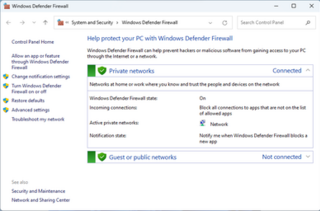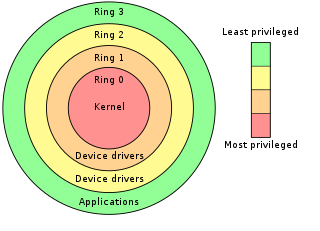Related Research Articles

Wake-on-LAN is an Ethernet or Token Ring computer networking standard that allows a computer to be turned on or awakened by a network message.

Mac OS X Server, is a discontinued series of Unix-like server operating systems developed by Apple Inc. based on macOS. It provided server functionality and system administration tools, and provided tools to manage both macOS-based computers and iOS-based devices.

In computing, the Preboot eXecution Environment, PXE specification describes a standardized client–server environment that boots a software assembly, retrieved from a network, on PXE-enabled clients. On the client side it requires only a PXE-capable network interface controller (NIC), and uses a small set of industry-standard network protocols such as DHCP and TFTP.
RealVNC is a company that provides remote access software. The software consists of a server and client application for the Virtual Network Computing (VNC) protocol to control another computer's screen remotely.
Remote administration refers to any method of controlling a computer from a remote location. Software that allows remote administration is becoming increasingly common and is often used when it is difficult or impractical to be physically near a system in order to use it. A remote location may refer to a computer in the next room or one on the other side of the world. It may also refer to both legal and illegal remote administration.
WS-Management is a DMTF open standard defining a SOAP-based protocol for the management of servers, devices, applications and various Web services. WS-Management provides a common way for systems to access and exchange management information across the IT infrastructure.
The Intelligent Platform Management Interface (IPMI) is a set of computer interface specifications for an autonomous computer subsystem that provides management and monitoring capabilities independently of the host system's CPU, firmware and operating system. IPMI defines a set of interfaces used by system administrators for out-of-band management of computer systems and monitoring of their operation. For example, IPMI provides a way to manage a computer that may be powered off or otherwise unresponsive by using a network connection to the hardware rather than to an operating system or login shell. Another use case may be installing a custom operating system remotely. Without IPMI, installing a custom operating system may require an administrator to be physically present near the computer, insert a DVD or a USB flash drive containing the OS installer and complete the installation process using a monitor and a keyboard. Using IPMI, an administrator can mount an ISO image, simulate an installer DVD, and perform the installation remotely.

Windows Firewall is a firewall component of Microsoft Windows. It was first included in Windows XP SP2 and Windows Server 2003 SP1. Before the release of Windows XP Service Pack 2, it was known as the "Internet Connection Firewall."
Intel vPro technology is an umbrella marketing term used by Intel for a large collection of computer hardware technologies, including VT-x, VT-d, Trusted Execution Technology (TXT), and Intel Active Management Technology (AMT). When the vPro brand was launched, it was identified primarily with AMT, thus some journalists still consider AMT to be the essence of vPro.
In systems management, out-of-band management involves the use of management interfaces for managing networking equipment. Out-of-band (OOB) management is a networking term which refers to accessing and managing network infrastructure at remote locations, and doing it through a separate management plane from the production network. Cellular 4G and 5G networks are used today for out-of-band management and many manufacturers have it as a product offering. Out-of-band management is now considered an essential network component to ensure business continuity.

ProLiant is a brand of server computers that was originally developed and marketed by Compaq and currently marketed by Hewlett Packard Enterprise. After Compaq merged with Hewlett-Packard (HP), HP retired its NetServer brand in favor of the ProLiant brand. HP ProLiant systems led the x86 server market in terms of units and revenue during first quarter of 2010. The HP ProLiant servers offer many advanced server features such as redundant power supplies, Out-of-band management with iLO or Lights-out 100, Hot-swap components and up to 8-Socket systems.

Microsoft Hyper-V, codenamed Viridian, and briefly known before its release as Windows Server Virtualization, is a native hypervisor; it can create virtual machines on x86-64 systems running Windows. Starting with Windows 8, Hyper-V superseded Windows Virtual PC as the hardware virtualization component of the client editions of Windows NT. A server computer running Hyper-V can be configured to expose individual virtual machines to one or more networks. Hyper-V was first released with Windows Server 2008, and has been available without additional charge since Windows Server 2012 and Windows 8. A standalone Windows Hyper-V Server is free, but has a command-line interface only. The last version of free Hyper-V Server is Hyper-V Server 2019, which is based on Windows Server 2019.

Intel Active Management Technology (AMT) is hardware and firmware for remote out-of-band management of select business computers, running on the Intel Management Engine, a microprocessor subsystem not exposed to the user, intended for monitoring, maintenance, updating, and repairing systems. Out-of-band (OOB) or hardware-based management is different from software-based management and software management agents.

SharePoint is a web-based collaborative platform that integrates natively with Microsoft Office. Launched in 2001, SharePoint is primarily sold as a document management and storage system, but the product is highly configurable and its usage varies substantially among organizations.
Intel Active Management Technology (AMT) is hardware-based technology built into PCs with Intel vPro technology. AMT is designed to help sys-admins remotely manage and secure PCs out-of-band when PC power is off, the operating system (OS) is unavailable, software management agents are missing, or hardware has failed.
In virtualization, input/output virtualization is a methodology to simplify management, lower costs and improve performance of servers in enterprise environments. I/O virtualization environments are created by abstracting the upper layer protocols from the physical connections.

The Intel Management Engine (ME), also known as the Intel Manageability Engine, is an autonomous subsystem that has been incorporated in virtually all of Intel's processor chipsets since 2008. It is located in the Platform Controller Hub of modern Intel motherboards.
Goverlan Reach Systems Management is a remote support software created and distributed by Goverlan, Inc. Goverlan is an on-premises client management software designed for medium to large enterprises for remote control, active directory management, global configuration change management, and reporting within a Windows IT Infrastructure.

Windows Server 2016 is the eighth release of the Windows Server server operating system developed by Microsoft as part of the Windows NT family of operating systems. It was developed alongside Windows 10 and is the successor to the Windows 8.1-based Windows Server 2012 R2. The first early preview version became available on October 1, 2014 together with the first technical preview of System Center. Windows Server 2016 was released on September 26, 2016 at Microsoft's Ignite conference and broadly released for retail sale on October 12, 2016. It was succeeded by Windows Server 2019 and the Windows Server Semi-Annual Channel.